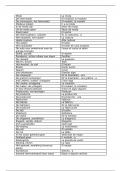VIR-20803
,Learning goals
• Know the characteristics of selected viral diseases
• Understand how viruses enter cells, replicate and cause disease
• Know the general building plan of viruses
• Apply the concept of triangulation, make simple calculations
• Understand basic methods in virology (see lecture 3 + 4)
Lecture 1 + 2 Introduction to Virology + E-
module
In rest, viruses are inert, "dead" particles, as soon as they infect a host cell they might start
to multiply rapidly, a process paralleled by pathological effects (diseases).
Acquired Immuno-Deficiency Syndrome (AIDS): Virus targets the immune system
Routes of virus transmission:
• Air
o Influenza, SARS
• Water
o Polio, diarrhea
• Contact
o HIV, Ebola, herpes
• Food
o Norovirus
• Vertical (offspring), germ line
o Plant virus
• Mosquito vectors
o Zika, malaria
• Bats as virus host
Most viruses are found in surface water
,What is a virus?
Viruses are the smallest genetic entities and their presence often causes infectious disease.
They are only visible with electron microscopy. A virus is a piece of genetic information with
a protein coat that hijacks the host cell and replicates itself. The cell will burst open and
million replications come free
The submicroscopic dimension of viruses was the main reason why it took very long before
viruses were identified at all, and even longer before the main characteristics of viruses
became known.
Characteristics of viruses
What is clear is that viruses show a large variety in morphological, functional and structural
characteristics.
1. Infectivity: property to penetrate a host cell, to multiply within this cell and to leave
the cell and spread to other cells
2. Obligate, intracellular parasite: they cannot replicate by their self. They need a living
host cell to replicate
a. No protein synthesizing machinery, they need the cell to produce proteins
b. No energy producing machinery, no mitochondrion, so needs the cell for this
3. Property to survive outside a living cell in an extracellular state
a. In an inert state or via carrier
b. Depends on the environment
Composition of viruses
Definition of a virus:
• A piece of genetic information (RNA or DNA),
• Protected by a protein coat and sometimes a lipid membrane/envelope,
• Which – upon infection of a living cell – will replace to vast amounts, coinciding with
pathological effects on the host
The disease symptoms are needed for the virus to transmit
,A virus is composed of:
• Nucleic acid
o RNA or DNA
▪ RNA = linear
o SS or DS
▪ Viral genome forms either a single or double-stranded helix
▪ Double helix: both strands base pair to each other due to
complementarity of the nucleotide sequence, similar to the dsDNA
genomes of cellular organism
o Segmented or non-segmented
• Protein shell
o Assembled from smaller subunits: the coat proteins
• Lipid membrane/viral envelope
o Some viruses
▪ HIV
o Made from the host cell
Viral DNA genomes may be linear or circular. All viral RNA genomes are linear, except the
genomes of viroids, which consist of circular, single-stranded RNA with no coding capacity
(i.e. viroid genomes do not encode proteins). Viroid’s are the ultimate “selfish genes”.
The exact properties of the viral genetic material depend on the family to which the virus
belongs.
The “minimal” virus: Need at least 2 genes:
o DNA- or RNA-polymerase
o Coat protein
Viral genome sizes:
Viroids occur in plants and their genomes are even smaller than viral genomes. As a
consequence, viroids lack essential information and can only replicate with the help of host
cell components (e.g. polymerase) or another virus.
The size of viral genomes varies between 2,000 and 1,000,000 nucleotides
, Mutation rate
Viruses and viroids have a higher mutation rate than cellular organisms (prokaryotes and
eukaryotes).
- Mutation rate is defined as the number of nucleotide positions per 1000 nt of
genome length that mutate per year.
- The nature of the genetic material and the number of generations per year affects
the mutation rate.
- RNA viruses mutate quicker than viruses with a DNA genome
o DNA polymerases (the enzymes that make a complimentary copy from a
template DNA), have proofreading ability, which means that they check their
work by comparing it to the template.
o RNA polymerases (the enzymes that synthesize RNA) do not have
proofreading ability and consequently make more mistakes.
This explains why most emerging viruses that threaten human health are RNA
viruses.



